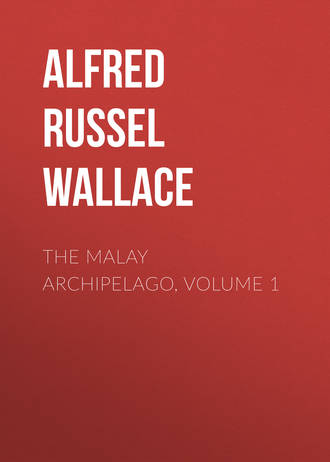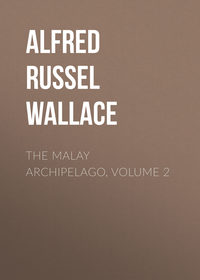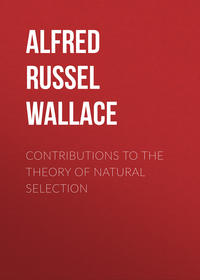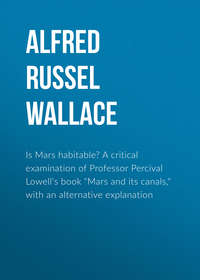 полная версия
полная версияThe Malay Archipelago, Volume 1
The land mammals are only seven in number, as follows: 1. The common monkey, Macacus cynomolgus, which is found in all the Indo-Malayan islands, and has spread from Java through Bali and Lombock to Timor. This species is very frequent on the banks of rivers, and may have been conveyed from island to island on trees carried down by floods. 2. Paradoxurus fasciatus; a civet cat, very common over a large part of the Archipelago. 3. Felis megalotis; a tiger cat, said to be peculiar to Timor, where it exists only in the interior, and is very rare. Its nearest allies are in Java. 4. Cervus timoriensis; a deer, closely allied to the Javan and Moluccan species, if distinct. 5. A wild pig, Sus timoriensis; perhaps the same as some of the Moluccan species. 6. A shrew mouse, Sorex tenuis; supposed to be peculiar to Timor. 7. An Eastern opossum, Cuscus orientalis; found also in the Moluccas, if not a distinct species.
The fact that not one of these species is Australian or nearly allied to any Australian form, is strongly corroborative of the opinion that Timor has never formed a part of that country; as in that case some kangaroo or other marsupial animal would almost certainly be found there. It is no doubt very difficult to account for the presence of some of the few mammals that do exist in Timor, especially the tiger cat and the deer. We must consider, however, that during thousands, and perhaps hundreds of thousands of years, these islands and the seas between them have been subjected to volcanic action. The land has been raised and has sunk again; the straits have been narrowed or widened; many of the islands may have been joined and dissevered again; violent floods have again and again devastated the mountains and plains, carrying out to sea hundreds of forest trees, as has often happened during volcanic eruptions in Java; and it does not seem improbable that once in a thousand, or ten thousand years, there should have occurred such a favourable combination of circumstances as would lead to the migration of two or three land animals from one island to another. This is all that we need ask to account for the very scanty and fragmentary group of Mammalia which now inhabit the large island of Timor. The deer may very probably have been introduced by man, for the Malays often keep tame fawns; and it may not require a thousand, or even five hundred years, to establish new characters in an animal removed to a country so different in climate and vegetation as is Timor from the Moluccas. I have not mentioned horses, which are often thought to be wild in Timor, because there are no grounds whatever for such a belief. The Timor ponies have every one an owner, and are quite as much domesticated animals as the cattle on a South American hacienda.
I have dwelt at some length upon the origin of the Timorese fauna because it appears to be a most interesting and instructive problem. It is very seldom that we can trace the animals of a district so clearly as we can in this case to two definite sources, and still more rarely that they furnish such decisive evidence of the time, the manner, and the proportions of their introduction. We have here a group of Oceanic Islands in miniature—islands which have never formed part of the adjacent lands, although so closely approaching them; and their productions have the characteristics of true Oceanic Islands slightly modified. These characteristics are: the absence all Mammalia except bats; and the occurrence of peculiar species of birds, insects, and land shells, which, though found nowhere else, are plainly related to those of the nearest land. Thus, we have an entire absence of all Australian mammals, and the presence of only a few stragglers from the west which can be accounted for in the manner already indicated. Bats are tolerably abundant.
Birds have many peculiar species, with a decided relationship to those of the two nearest masses of land. The insects have similar relations with the birds. As an example, four species of the Papilionidae are peculiar to Timor, three others are also found in Java, and one in Australia. Of the four peculiar species two are decided modifications of Javanese forms, while the others seem allied to those of the Moluccas and Celebes. The very few land shells known are all, curiously enough, allied to or identical with Moluccan or Celebes forms. The Pieridae (white and yellow butterflies) which wander more, and from frequenting open grounds, are more liable to be blown out to sea, seem about equally related to those of Java, Australia, and the Moluccas.
It has been objected to in Mr. Darwin's theory, of Oceanic Islands having never been connected with the mainland, that this would imply that their animal population was a matter of chance; it has been termed the "flotsam and jetsam theory," and it has been maintained that nature does not work by the "CHAPTER of accidents." But in the case which I have here described, we have the most positive evidence that such has been the mode of peopling the islands. Their productions are of that miscellaneous character which we should expect from such an origin; and to suppose that they have been portions of Australia or of Java will introduce perfectly gratuitous difficulties, and render it quite impossible to explain those curious relations which the best known group of animals (the birds) have been shown to exhibit. On the other hand, the depth of the surrounding seas, the form of the submerged banks, and the volcanic character of most of the islands, all point to an independent origin.
Before concluding, I must make one remark to avoid misapprehension. When I say that Timor has never formed part of Australia, I refer only to recent geological epochs. In Secondary or even Eocene or Miocene times, Timor and Australia may have been connected; but if so, all record of such a union has been lost by subsequent submergence, and in accounting for the present land-inhabitants of any country we have only to consider those changes which have occurred since its last elevation above the waters. Since such last elevation, I feel confident that Timor has not formed part of Australia.
CHAPTER XV. CELEBES
(MACASSAR, SEPTEMBER TO NOVEMBER, 1856.)I LEFT Lombock on the 30th of August, and reached Macassar in three days. It was with great satisfaction that I stepped on a shore which I had been vainly trying to reach since February, and where I expected to meet with so much that was new and interesting.
The coast of this part of Celebes is low and flat, lined with trees and villages so as to conceal the interior, except at occasional openings which show a wide extent of bare and marshy rice-fields. A few hills of no great height were visible in the background; but owing to the perpetual haze over the land at this time of the year, I could nowhere discern the high central range of the peninsula, or the celebrated peak of Bontyne at its southern extremity. In the roadstead of Macassar there was a fine 42-gun frigate, the guardship of the place, as well as a small war steamer and three or four little cutters used for cruising after the pirates which infest these seas. There were also a few square-rigged trading-vessels, and twenty or thirty native praus of various sizes. I brought letters of introduction to a Dutch gentleman, Mr. Mesman, and also to a Danish shopkeeper, who could both speak English and who promised to assist me in finding a place to stay, suitable for my pursuits. In the meantime, I went to a kind of clubhouse, in default of any hotel in the place.
Macassar was the first Dutch town I had visited, and I found it prettier and cleaner than any I had yet seen in the East. The Dutch have some admirable local regulations. All European houses must be kept well white-washed, and every person must, at four in the afternoon, water the road in front of his house. The streets are kept clear of refuse, and covered drains carry away all impurities into large open sewers, into which the tide is admitted at high-water and allowed to flow out when it has ebbed, carrying all the sewage with it into the sea. The town consists chiefly of one long narrow street along the seaside, devoted to business, and principally occupied by the Dutch and Chinese merchants' offices and warehouses, and the native shops or bazaars. This extends northwards for more than a mile, gradually merging into native houses often of a most miserable description, but made to have a neat appearance by being all built up exactly to the straight line of the street, and being generally backed by fruit trees. This street is usually thronged with a native population of Bugis and Macassar men, who wear cotton trousers about twelve inches long, covering only from the hip to half-way down the thigh, and the universal Malay sarong, of gay checked colours, worn around the waist or across the shoulders in a variety of ways. Parallel to this street run two short ones which form the old Dutch town, and are enclosed by gates. These consist of private houses, and at their southern end is the fort, the church, and a road at right angles to the beach, containing the houses of the Governor and of the principal officials. Beyond the fort, again along the beach, is another long street of native huts and many country-houses of the tradesmen and merchants. All around extend the flat rice-fields, now bare and dry and forbidding, covered with dusty stubble and weeds. A few months back these were a mass of verdure, and their barren appearance at this season offered a striking contrast to the perpetual crops on the same kind of country in Lombock and Bali, where the seasons are exactly similar, but where an elaborate system of irrigation produces the effect of a perpetual spring.
The day after my arrival I paid a visit of ceremony to the Governor, accompanied by my friend the Danish merchant, who spoke excellent English. His Excellency was very polite, and offered me every facility for travelling about the country and prosecuting my researches in natural history. We conversed in French, which all Dutch officials speak very well.
Finding it very inconvenient and expensive to stay in the town, I removed at the end of a week to a little bamboo house, kindly offered me by Mr. Mesman. It was situated about two miles away, on a small coffee plantation and farm, and about a mile beyond Mr. M.'s own country-house. It consisted of two rooms raised about seven feet above the ground, the lower part being partly open (and serving excellently to skin birds in) and partly used as a granary for rice. There was a kitchen and other outhouses, and several cottages nearby, occupied by men in Mr. M.'s employ.
After being settled a few days in my new house, I found that no collections could be made without going much further into the country. The rice-fields for some miles around resembled English stubbles late in autumn, and were almost as unproductive of bird or insect life. There were several native villages scattered about, so embosomed in fruit trees that at a distance they looked like clumps or patches of forest. These were my only collecting places; but they produced a very limited number of species, and were soon exhausted. Before I could move to any more promising district it was necessary to obtain permission from the Rajah of Goa, whose territories approach to within two miles of the town of Macassar. I therefore presented myself at the Governor's office and requested a letter to the Rajah, to claim his protection, and permission to travel in his territories whenever I might wish to do so. This was immediately granted, and a special messenger was sent with me to carry the letter.
My friend Mr. Mesman kindly lent me a horse, and accompanied me on my visit to the Rajah, with whom he was great friends. We found his Majesty seated out of doors, watching the erection of a new house. He was naked from the waist up, wearing only the usual short trousers and sarong. Two chairs were brought out for us, but all the chiefs and other natives were seated on the ground. The messenger, squatting down at the Rajah's feet, produced the letter, which was sewn up in a covering of yellow silk. It was handed to one of the chief officers, who ripped it open and returned it to the Rajah, who read it, and then showed it to Mr. M., who both speaks and reads the Macassar language fluently, and who explained fully what I required. Permission was immediately granted me to go where I liked in the territories of Goa, but the Rajah desired, that should I wish to stay any time at a place I would first give him notice, in order that he might send someone to see that no injury was done me. Some wine was then brought us, and afterwards some detestable coffee and wretched sweetmeats, for it is a fact that I have never tasted good coffee where people grow it themselves.
Although this was the height of the dry season, and there was a fine wind all day, it was by no means a healthy time of year. My boy Ali had hardly been a day on shore when he was attacked by fever, which put me to great inconvenience, as at the house where I was staying, nothing could be obtained but at mealtime. After having cured Ali, and with much difficulty got another servant to cook for me, I was no sooner settled at my country abode than the latter was attacked with the same disease; and, having a wife in the town, left me. Hardly was he gone than I fell ill myself with strong intermittent fever every other day. In about a week I got over it, by a liberal use of quinine, when scarcely was I on my legs than Ali again became worse than ever. Ali's fever attacked him daily, but early in the morning he was pretty well, and then managed to cook enough for me for the day. In a week I cured him, and also succeeded in getting another boy who could cook and shoot, and had no objection to go into the interior. His name was Baderoon, and as he was unmarried and had been used to a roving life, having been several voyages to North Australia to catch trepang or "beche de mer", I was in hopes of being able to keep him. I also got hold of a little impudent rascal of twelve or fourteen, who could speak some Malay, to carry my gun or insect-net and make himself generally useful. Ali had by this time become a pretty good bird-skinner, so that I was fairly supplied with servants.
I made many excursions into the country, in search of a good station for collecting birds and insects. Some of the villages a few miles inland are scattered about in woody ground which has once been virgin forest, but of which the constituent trees have been for the most part replaced by fruit trees, and particularly by the large palm, Arenga saccharifera, from which wine and sugar are made, and which also produces a coarse black fibre used for cordage. That necessary of life, the bamboo, has also been abundantly planted. In such places I found a good many birds, among which were the fine cream-coloured pigeon, Carpophaga luctuosa, and the rare blue-headed roller, Coracias temmincki, which has a most discordant voice, and generally goes in pairs, flying from tree to tree, and exhibiting while at rest that all-in-a-heap appearance and jerking motion of the head and tail which are so characteristic of the great Fissirostral group to which it belongs. From this habit alone, the kingfishers, bee-eaters, rollers, trogons, and South American puff-birds, might be grouped together by a person who had observed them in a state of nature, but who had never had an opportunity of examining their form and structure in detail. Thousands of crows, rather smaller than our rook, keep up a constant cawing in these plantations; the curious wood-swallows (Artami), which closely resemble swallows in their habits and flight but differ much in form and structure, twitter from the tree-tops; while a lyre-tailed drongo-shrike, with brilliant black plumage and milk-white eyes, continually deceives the naturalist by the variety of its unmelodious notes.
In the more shady parts butterflies were tolerably abundant; the most common being species of Euplaea and Danais, which frequent gardens and shrubberies, and owing to their weak flight are easily captured. A beautiful pale blue and black butterfly, which flutters along near the ground among the thickets, and settles occasionally upon flowers, was one of the most striking; and scarcely less so, was one with a rich orange band on a blackish ground—these both belong to the Pieridae, the group that contains our common white butterflies, although differing so much from them in appearance. Both were quite new to European naturalists. [The former has been named Eronia tritaea; the latter Tachyris ithonae.] Now and then I extended my walks some miles further, to the only patch of true forest I could find, accompanied by my two boys with guns and insect-net. We used to start early, taking our breakfast with us, and eating it wherever we could find shade and water. At such times my Macassar boys would put a minute fragment of rice and meat or fish on a leaf, and lay it on a stone or stump as an offering to the deity of the spot; for though nominal Mahometans the Macassar people retain many pagan superstitions, and are but lax in their religious observances. Pork, it is true, they hold in abhorrence, but will not refuse wine when offered them, and consume immense quantities of "sagueir," or palm-wine, which is about as intoxicating as ordinary beer or cider. When well made it is a very refreshing drink, and we often took a draught at some of the little sheds dignified by the name of bazaars, which are scattered about the country wherever there is any traffic.
One day Mr. Mesman told me of a larger piece of forest where he sometimes went to shoot deer, but he assured me it was much further off, and that there were no birds. However, I resolved to explore it, and the next morning at five o'clock we started, carrying our breakfast and some other provisions with us, and intending to stay the night at a house on the borders of the wood. To my surprise two hours' hard walking brought us to this house, where we obtained permission to pass the night. We then walked on, Ali and Baderoon with a gun each, Baso carrying our provisions and my insect-box, while I took only my net and collecting-bottle and determined to devote myself wholly to the insects. Scarcely had I entered the forest when I found some beautiful little green and gold speckled weevils allied to the genus Pachyrhynchus, a group which is almost confined to the Philippine Islands, and is quite unknown in Borneo, Java, or Malacca. The road was shady and apparently much trodden by horses and cattle, and I quickly obtained some butterflies I had not before met with. Soon a couple of reports were heard, and coming up to my boys I found they had shot two specimens of one of the finest of known cuckoos, Phoenicophaus callirhynchus. This bird derives its name from its large bill being coloured of a brilliant yellow, red, and black, in about equal proportions. The tail is exceedingly long, and of a fine metallic purple, while the plumage of the body is light coffee brown. It is one of the characteristic birds of the island of Celebes, to which it is confined.
After sauntering along for a couple of hours we reached a small river, so deep that horses could only cross it by swimming, so we had to turn back; but as we were getting hungry, and the water of the almost stagnant river was too muddy to drink, we went towards a house a few hundred yards off. In the plantation we saw a small raised hut, which we thought would do well for us to breakfast in, so I entered, and found inside a young woman with an infant. She handed me a jug of water, but looked very much frightened. However, I sat down on the doorstep, and asked for the provisions. In handing them up, Baderoon saw the infant, and started back as if he had seen a serpent. It then immediately struck me that this was a hut in which, as among the Dyaks of Borneo and many other savage tribes, the women are secluded for some time after the birth of their child, and that we did very wrong to enter it; so we walked off and asked permission to eat our breakfast in the family mansion close at hand, which was of course granted. While I ate, three men, two women, and four children watched every motion, and never took eyes off me until I had finished.
On our way back in the heat of the day, I had the good fortune to capture three specimens of a fine Ornithoptera, the largest, the most perfect, and the most beautiful of butterflies. I trembled with excitement as I took the first out of my net and found it to be in perfect condition. The ground colour of this superb insect was a rich shining bronzy black, the lower wings delicately grained with white, and bordered by a row of large spots of the most brilliant satiny yellow. The body was marked with shaded spots of white, yellow, and fiery orange, while the head and thorax were intense black. On the under-side the lower wings were satiny white, with the marginal spots half black and half yellow. I gazed upon my prize with extreme interest, as I at first thought it was quite a new species. It proved however to be a variety of Ornithoptera remus, one of the rarest and most remarkable species of this highly esteemed group. I also obtained several other new and pretty butterflies. When we arrived at our lodging-house, being particularly anxious about my insect treasures, I suspended the box from a bamboo on which I could detect no sign of ants, and then began skinning some of my birds. During my work I often glanced at my precious box to see that no intruders had arrived, until after a longer spell of work than usual I looked again, and saw to my horror that a column of small red ants were descending the string and entering the box. They were already busy at work at the bodies of my treasures, and another half-hour would have seen my whole day's collection destroyed. As it was, I had to take every insect out, clean them thoroughly as well as the box, and then seek a place of safety for them. As the only effectual one, I begged a plate and a basin from my host, filled the former with water, and standing the latter in it placed my box on the top, and then felt secure for the night; a few inches of clean water or oil being the only barrier these terrible pests are not able to pass.
On returning home to Mamajam (as my house was called) I had a slight return of intermittent fever, which kept me some days indoors. As soon as I was well, I again went to Goa, accompanied by Mr. Mesman, to beg the Rajah's assistance in getting a small house built for me near the forest. We found him at a cock-fight in a shed near his palace, which however, he immediately left to receive us, and walked with us up an inclined plane of boards which serves for stairs to his house. This was large, well-built, and lofty, with bamboo floor and glass windows. The greater part of it seemed to be one large hall divided by the supporting posts. Near a window sat the Queen, squatting on a rough wooden arm-chair, chewing the everlasting sirih and betel-nut, while a brass spittoon by her side and a sirih-box in front were ready to administer to her wants. The Rajah seated himself opposite to her in a similar chair, and a similar spittoon and sirih-box were held by a little boy squatting at his side. Two other chairs were brought for us. Several young women, some the Rajah's daughters, others slaves, were standing about; a few were working at frames making sarongs, but most of them were idle.
And here I might (if I followed the example of most travellers) launch out into a glowing description of the charms of these damsels, the elegant costumes they wore, and the gold and silver ornaments with which they were adorned. The jacket or body of purple gauze would figure well in such a description, allowing the heaving bosom to be seen beneath it, while "sparkling eyes," and "jetty tresses," and "tiny feet" might be thrown in profusely. But, alas! regard for truth will not permit me to expatiate too admiringly on such topics, determined as I am to give as far as I can a true picture of the people and places I visit. The princesses were, it is true, sufficiently good-looking, yet neither their persons nor their garments had that appearance of freshness and cleanliness without which no other charms can be contemplated with pleasure. Everything had a dingy and faded appearance, very disagreeable and unroyal to a European eye. The only thing that excited some degree of admiration was the quiet and dignified manner of the Rajah and the great respect always paid to him. None can stand erect in his presence, and when he sits on a chair, all present (Europeans of course excepted) squat upon the ground. The highest seat is literally, with these people, the place of honour and the sign of rank. So unbending are the rules in this respect, that when an English carriage which the Rajah of Lombock had sent for arrived, it was found impossible to use it because the driver's seat was the highest, and it had to be kept as a show in its coach house. On being told the object of my visit, the Rajah at once said that he would order a house to be emptied for me, which would be much better than building one, as that would take a good deal of time. Bad coffee and sweetmeats were given us as before.









